本文讲述 Mybatis 通过 on duplicate key update 实现批量插入或覆盖更新。
使用要点
(1) 表要求必须有主键或唯一索引才能起效果,否则 insert 或 update 无效;
(2) 注意语法 on duplicate key update 后面应为需要更新字段。
(3) 相较于 replace into(insert加强版,不存在时insert,存在时先delete后insert)虽然也能达到批量更新目的,但因为删除和添加需要重复维护索引,所以大批量比 on duplicate key update 性能要差,小量可忽略,自选为主。
以 article表为例:
CREATE TABLE `article` (
`id` int(10) NOT NULL AUTO_INCREMENT COMMENT '文章的唯一ID',
`author` varchar(50) DEFAULT NULL COMMENT '作者',
`title` varchar(100) DEFAULT NULL COMMENT '标题',
`content` longtext COMMENT '文章的内容',
PRIMARY KEY (`id`)
) ENGINE=InnoDB AUTO_INCREMENT=31 DEFAULT CHARSET=utf8
单条的插入或者更新
<insert id="insertOrUpdate" keyColumn="id" keyProperty="id" parameterType="com.itjing.generator.entity.Article" useGeneratedKeys="true">
insert into article
<trim prefix="(" suffix=")" suffixOverrides=",">
<if test="id != null">
id,
</if>
author,
title,
content,
</trim>
values
<trim prefix="(" suffix=")" suffixOverrides=",">
<if test="id != null">
#{id,jdbcType=INTEGER},
</if>
#{author,jdbcType=VARCHAR},
#{title,jdbcType=VARCHAR},
#{content,jdbcType=LONGVARCHAR},
</trim>
on duplicate key update
<trim suffixOverrides=",">
<if test="id != null">
id = #{id,jdbcType=INTEGER},
</if>
author = #{author,jdbcType=VARCHAR},
title = #{title,jdbcType=VARCHAR},
content = #{content,jdbcType=LONGVARCHAR},
</trim>
</insert>
单条的插入或者更新(根据有效字段)
<insert id="insertOrUpdateSelective" keyColumn="id" keyProperty="id" parameterType="com.itjing.generator.entity.Article" useGeneratedKeys="true">
insert into article
<trim prefix="(" suffix=")" suffixOverrides=",">
<if test="id != null">
id,
</if>
<if test="author != null">
author,
</if>
<if test="title != null">
title,
</if>
<if test="content != null">
content,
</if>
</trim>
values
<trim prefix="(" suffix=")" suffixOverrides=",">
<if test="id != null">
#{id,jdbcType=INTEGER},
</if>
<if test="author != null">
#{author,jdbcType=VARCHAR},
</if>
<if test="title != null">
#{title,jdbcType=VARCHAR},
</if>
<if test="content != null">
#{content,jdbcType=LONGVARCHAR},
</if>
</trim>
on duplicate key update
<trim suffixOverrides=",">
<if test="id != null">
id = #{id,jdbcType=INTEGER},
</if>
<if test="author != null">
author = #{author,jdbcType=VARCHAR},
</if>
<if test="title != null">
title = #{title,jdbcType=VARCHAR},
</if>
<if test="content != null">
content = #{content,jdbcType=LONGVARCHAR},
</if>
</trim>
</insert>
批量插入
<insert id="batchInsert" keyColumn="id" keyProperty="id" parameterType="map" useGeneratedKeys="true">
insert into article
(author, title, content)
values
<foreach collection="list" item="item" separator=",">
(#{item.author,jdbcType=VARCHAR}, #{item.title,jdbcType=VARCHAR}, #{item.content,jdbcType=LONGVARCHAR}
)
</foreach>
</insert>
批量插入或者更新(如果更新时字段值有效则更新)
<insert id="batchInsert" keyColumn="id" keyProperty="id" parameterType="map" useGeneratedKeys="true">
insert into article
(author, title, content)
values
<foreach collection="list" item="item" separator=",">
(#{item.author,jdbcType=VARCHAR}, #{item.title,jdbcType=VARCHAR}, #{item.content,jdbcType=LONGVARCHAR}
)
</foreach>
on duplicate key update
id = IF(ISNULL(VALUES(id)),id,VALUES(id)),
author = IF(ISNULL(VALUES(author)),author,VALUES(author)),
title = IF(ISNULL(VALUES(title)),title,VALUES(title)),
content = IF(ISNULL(VALUES(content)),content,VALUES(content))
</insert>
比如利用 自动生成工具生成的 insertOrUpdate 的 on duplicate key update后面的内容为:
id = #{id,jdbcType=INTEGER},
author = #{author,jdbcType=VARCHAR},
title = #{title,jdbcType=VARCHAR},
content = #{content,jdbcType=LONGVARCHAR},
我们可以利用这段内容通过 nodepad3 替换成我们需要的内容。
在 nodepad3 中输入 ctrl + H 进入替换页面。
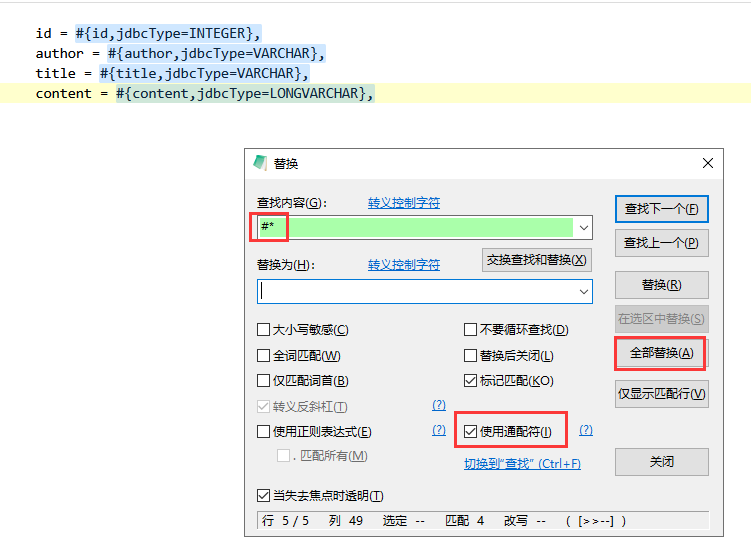
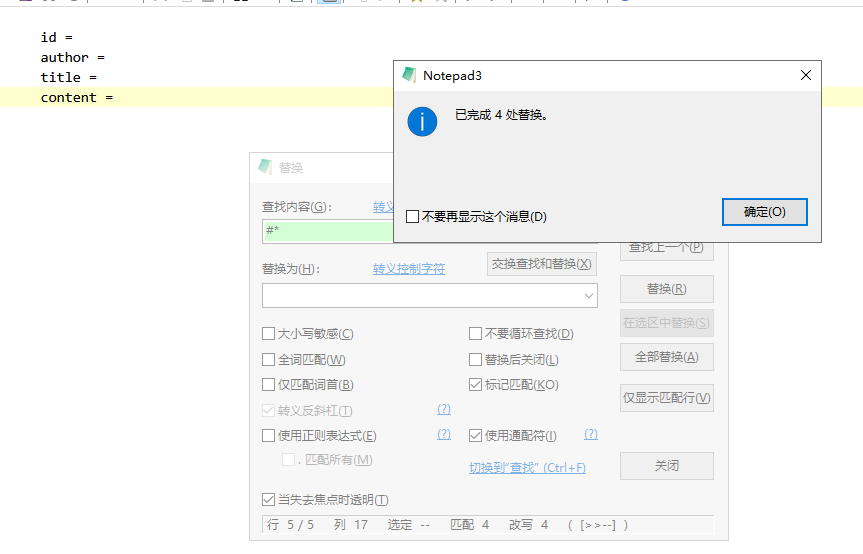
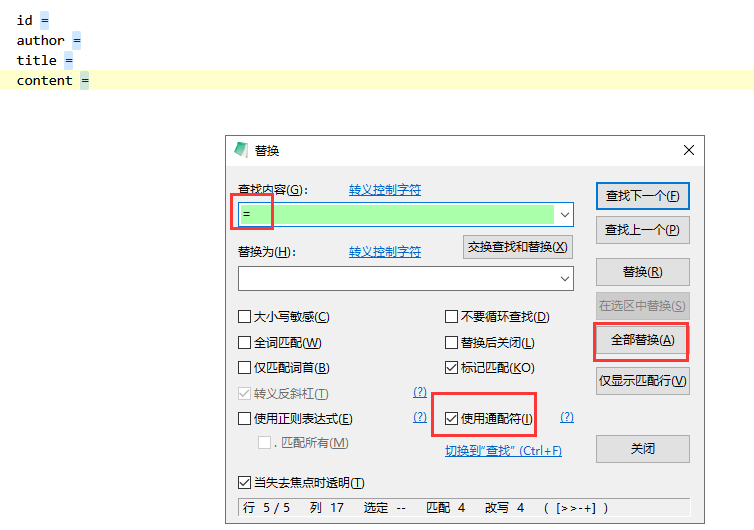
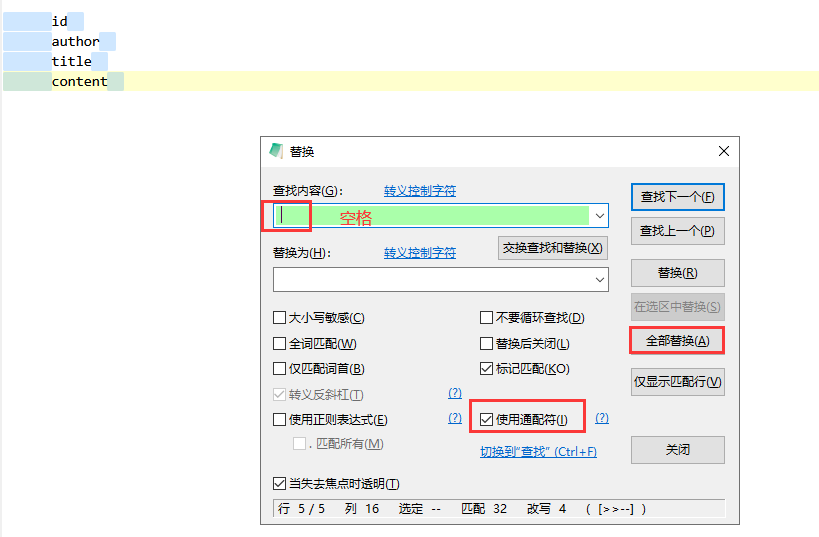
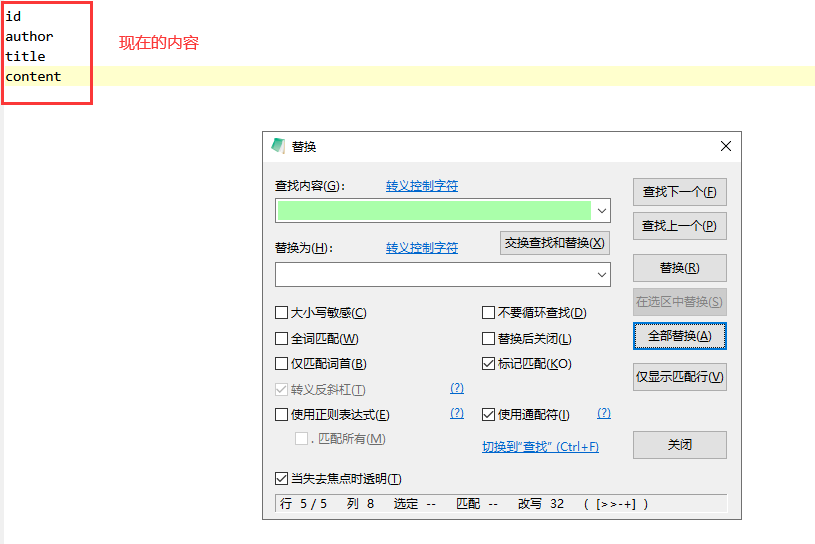
然后使用正则表达式将其替换成我们需要的内容:
(.+) # 匹配某行全部内容
$1 = IF(ISNULL(VALUES($1)),$1,VALUES($1)), # 替换后内容,$1为之前匹配内容

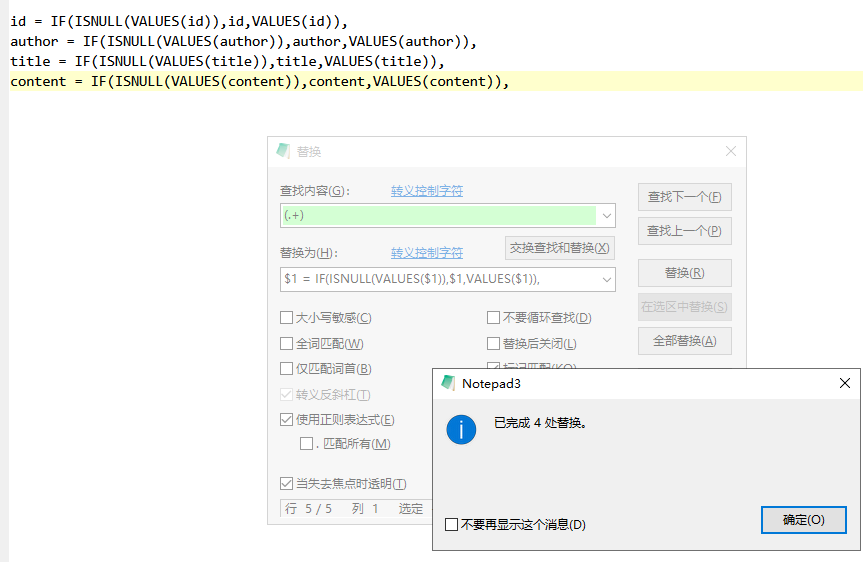
如下则为我们需要的内容,注意最后没有逗号:
id = IF(ISNULL(VALUES(id)),id,VALUES(id)),
author = IF(ISNULL(VALUES(author)),author,VALUES(author)),
title = IF(ISNULL(VALUES(title)),title,VALUES(title)),
content = IF(ISNULL(VALUES(content)),content,VALUES(content))
将上述内容放到 on duplicate key update 后面即可。
这样的话,如果更新时,插入值为 null ,则使用原值。
如果在字段多的情况下,可以使用上述方式去生成替换,字段少的话手动也是可以的。
本文只是本人突发奇想做个记录,留个笔记。


评论区